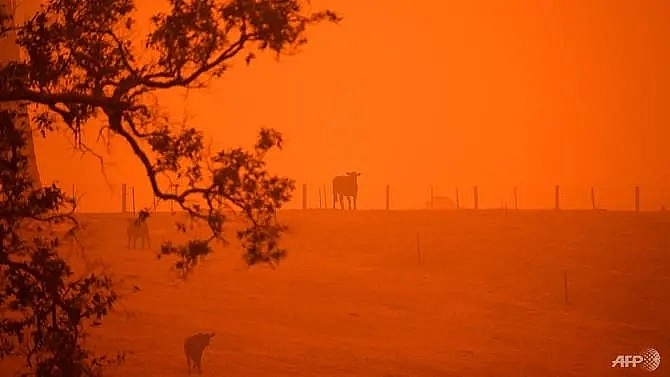Nearly US$17m raised as Australia reels from bushfire fury
 |
| Cattle stand in a field under a red sky caused by bushfires in Greendale on the outskirts of Bega, in Australia's New South Wales state on Jan 5, 2020. (Photo: AFP / SAEED KHAN) |
East coast seaside towns were plunged into darkness, ash rained down on rural communities and major cities were again cloaked in choking smoke, even as stunned Australians tried to regroup amid a wave of cooler air and light rain.
The weekend marked some of the worst days in the country's deadly bushfire crisis, with hundreds more properties destroyed and the overall death toll climbing to 24, including a man who died on Saturday trying to save a friend's home.
Comedian Celeste Barber used her international social media fame to launch a Facebook fundraiser for firefighters that almost reached its A$25 million (US$17 million) target in just three days with donations from all over the globe.
American pop star Pink said she would donate US$500,000 to the firefighters, a donation matched by Australian actress Nicole Kidman.
World No 1 Ash Barty pledged to hand over all her winnings from this week's Brisbane International tennis tournament - potentially US$250,000 - to the Red Cross.
Around 200 fires continued to burn Sunday, many out of control, although only a handful prompted emergency warnings as temperatures dipped.
Everywhere, millions of beleaguered residents struggled to come to grips with a catastrophe that has taken place on a near-continental scale, unfurled over months and altered daily life.
"We're in uncharted territory," New South Wales Premier Gladys Berejiklian said. "We can't pretend that this is something that we have experienced before. It's not."
Authorities have struggled to keep pace with the severity of the crisis - which has now scorched an area almost the size of Ireland.
While bushfires are common in Australia's dry summers, climate change has pushed up land and sea temperatures and led to more extremely hot days and severe fire seasons.
DECADES TO RECOVER
Prime Minister Scott Morrison on Saturday announced the largest military call-up in living memory, mobilising up to 3,000 reservists to assist exhausted volunteer firefighters.
Warships and combat helicopters have already been repurposed to help with the largest maritime evacuation in Australia since World War II - moving to safety some of the 4,000 people trapped for days on the foreshore of Mallacoota, midway between Sydney and Melbourne.
Up and down the coast, thousands of people remained displaced and many more weighed an uncertain future.
Noreen Ralston-Birchaw, 75, lost her home in Mogo on New Year's Eve and said she was unsure what to do.
"At this very moment, I don't want to go back and see my house laying burnt on the ground," she told AFP. "I don't want to rebuild there."
Morrison also announced the establishment of a Bushfire Recovery Agency, that will run for at least two years and help survivors get back on their feet, a signal that the path ahead will be long and difficult.
Even for those not in the fires' direct path, the crisis has put Australia's much-admired outdoor lifestyle on hold: barbecues have been barred under blanket fire bans, top sporting events have been called off and beach trips cancelled.
The country's distinctive flora and fauna will take years or decades to recover - countless thousands of gum trees have been lost and experts on Kangaroo Island said half the koala population has been wiped out.
Queen Elizabeth II on Sunday said she was "deeply saddened" by the fires, and thanked the emergency services "who put their own lives in danger" to help communities.
EASING CONDITIONS
Sunday brought milder conditions including some rainfall in New South Wales and neighbouring Victoria state but some communities were still under threat from out-of-control blazes, particularly in and around the town of Eden in New South Wales near the Victorian border.
"The sky is still red," said John Steele, 73, who was evacuated with his wife from their rural property north of Eden late Saturday. "We're not out of the woods yet."
In Cooma, in inland southern New South Wales, the fire crisis turned into a flood disaster when a large tower carrying 4.5 million litres of water swept away cars and filled homes with mud.
"First bushfire and now flood, back-to-back disasters," a shaken resident who asked not to be named told AFP.
Australia's capital Canberra was ranked as the city with the poorest air quality in the world on Sunday by Air Visual, an independent online air quality index monitor, amid a severe haze caused by the fires.
Flights were cancelled, galleries were closed to safeguard public health and a large consignment of facemasks was being brought in.
In some rural areas affected by fires, police patrolled the streets amid reports of looting and break-ins.
What the stars mean:
★ Poor ★ ★ Promising ★★★ Good ★★★★ Very good ★★★★★ Exceptional
Related Contents
Latest News
More News
- 72 nations sign landmark Hanoi cybercrime convention (October 26, 2025 | 18:00)
- UN Secretary-General commends Vietnam’s global leadership (October 26, 2025 | 09:00)
- APEC finance ministers convene to tackle regional challenges (October 22, 2025 | 17:31)
- Rewiring global trade: ASEAN’s rise as supply chain hub (October 17, 2025 | 11:40)
- Vietnam attends first World Nuclear Week Forum in Russia (September 26, 2025 | 10:50)
- Vietnam attends 69th session of IAEA General Conference (September 16, 2025 | 10:00)
- ADB, WB pledge over 12 billion USD for ASEAN power grid, renewable energy projects (August 15, 2025 | 14:18)
- Lowy Institute proposes AI-based tobacco control solutions for ASEAN (August 15, 2025 | 14:14)
- Cloud computing policy to position Malaysia as regional hub by 2030 (August 15, 2025 | 14:11)
- Thailand, Cambodia suffer numerous cyber attacks (August 05, 2025 | 16:19)

 Tag:
Tag:




















 Mobile Version
Mobile Version